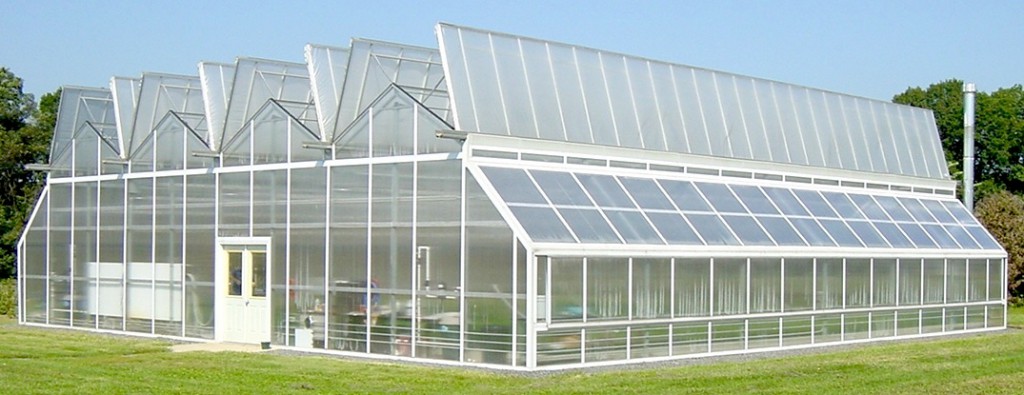Main Content
By A.J. Both, PhD Bioresource Engineering, Horticultural Engineering | Center for Controlled Environment Agriculture

Controlled Environment Agriculture (CEA) crop production encompasses growing systems for bedding plants, pot plants, cut flowers, plugs, and vegetables. CEA production incorporates some type of structure with related environmental control and plant growing systems. The structures range from simple shades to fully enclosed structures. The degree of environmental control ranges from simple manual operation that controls a limited number of environmental parameters, to highly sophisticated computer control of all impacting environmental parameters. Similarly, the growing systems employed range from entirely manual to totally automated. Often, the availability, affordability, and skill of the labor force significantly determine the necessary degree of environmental control and growing system automation. CEA systems are specifically designed to overcome the vagaries of outside weather conditions.
Growing structures used for CEA crop production can be divided into two groups: single span and multi span (gutter connected) structures. These structures generally have either curved or peaked roofs and can be glazed with a variety of cladding materials such as plastic film (e.g., polyethylene), rigid plastic panels (e.g., polycarbonate or acrylic), or glass. Their foundations range from hollow posts driven into the ground to poured concrete foundations. Structural components can be wood (or similar materials such as bamboo), rigid plastic, aluminum, and steel (often treated: e.g., galvanized steel). All structures need to be designed to withstand local weather conditions (wind, snow, hail, etc.), and strong enough to support equipment (e.g., irrigation, supplemental lighting, and curtain systems) and in some cases crops (e.g., hanging baskets or vegetable crops supported by strings attached to the greenhouse structure). Multi span structures offer a clear advantage in terms of the heat energy required since their exposed outside surface area per unit floor area is less compared to single span structures. Often, space utilization (ratio of the usable growing area and the total production area) in multi span structures is higher compared to single span structures. Many commercial designs rely on standardized dimensions (e.g., distance between the posts, width of a bay, width of a roof section, length of a bay, etc.) to reduce design and manufacturing costs.
Growing systems for CEA crops exist on the floor (in the soil or sand, on top of gravel or a protective fabric, or on concrete) or on benches (fixed or movable). Integrated in the floor or the benches can be heating and irrigation systems (heated ebb and flood floors and benches). The movement of plant material (if any) through the facility can range from manual to fully automated with the movement of benches (tables) directed by a computer control system. For some crops (e.g., bedding plants), rolling benches are used to move the plant material outside during the day to harden off the crop. Overhead growing systems consist of stationary or movable hanging baskets, and each system can be equipped with a dedicated irrigation system. A specialized crop production system often associated with CEA systems is hydroponics. In hydroponic systems, the rooting medium is often inorganic and limited to small volumes. Water and nutrients are provided to the plant roots continuously or at very regular intervals allowing for precise control of plant growth and development. Obviously, these systems need to be designed with redundancy and robustness since even short interruptions can cause significant crop losses.
High Tunnel Production Links
- Hightunnels.org
- Pennsylvania State University Plasticulture
- Rutgers University Center for Controlled Environment Agriculture
- NE-SARE High Tunnels Information
- West Virginia University ANR Commercial Agriculture High Tunnels
Greenhouse Vegetable Production Links
- ATTRA Greenhouse Information
- Cornell University Controlled Environment Agriculture
- North Carolina State University Greenhouse Vegetable Production
- Ohio State University Hydroponic Crop Program
- Rutgers University Center for Controlled Environment Agriculture
- University of Arizona Controlled Environment Agriculture Center
- University of Florida Protected Agriculture Project
Rutgers NJAES High Tunnel, Greenhouse Fact Sheets
- Important Diseases of Tomatoes Grown in High Tunnel and Greenhouses in New Jersey
- Creating a Master Plan for Greenhouse Operations
- Principles of Evaluating Greenhouse Aerial Environment – Part 1 of 3
- Instruments for Monitoring the Greenhouse Aerial Environment – Part 2 of 3
- Evaluating Greenhouse Mechanical Ventilation System Performance – Part 3 of 3
Additional Articles
- Greenhouse Temperature Management (171k PDF)
- Greenhouse Glazing (28k PDF)
- Greenhouse Energy Conservation (23k PDF)
- Greenhouse Energy Conservation Checklistt (201k PDF)
- Greenhouse Evaporative Cooling (504k PDF)
- Greenhouse Supplemental Lighting (47k PDF)
- Greenhouse Cooling Maintenance Tips (229k PDF)
- Greenhouse: Lower your Energy Bill (173k PDF)
- Greenhouse Solar and Wind Energy (113k PDF)
- Using an Energy Curtain in a High Tunnel (252k PDF)
- Designing Greenhouse Floor Heating Systems (575k PDF)